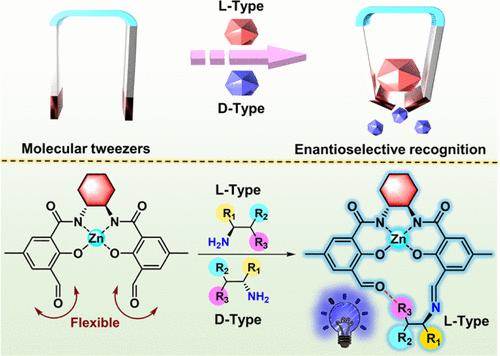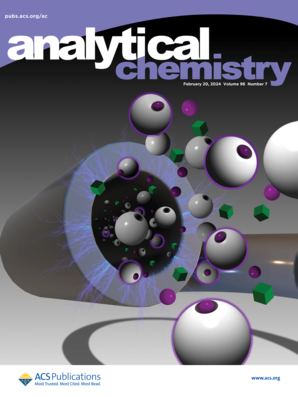Stimuli-Responsive Photoluminescent Molecular Tweezers for Highly Enantioselective Discrimination of Chiral Primary Amines
IF 6.7
1区 化学
Q1 CHEMISTRY, ANALYTICAL
引用次数: 0
Abstract
To address the challenge of chiral recognition in terms of efficiency and generality, we propose a novel fluorescence sensing approach by rationally designing metal-ion-responsive chiral molecular tweezers. The flexible and adaptable molecular tweezers enable facile recognition of 31 structurally varied chiral primary amine compounds, including amino acids, amino acid esters, and chiral amines. Notably, upon stimulation by zinc ions, the chiral molecular tweezers demonstrate a higher enantioselective fluorescence response. Combined density functional theory calculations reveal that the chiral sensing mechanism relies on differential reaction rates and potential hydrogen-bonding interactions between the two enantiomers and the chiral receptor, which results in one of the enantiomers forming a more abundant, stable, and structurally rigid complex with the receptor, resulting in a significant increase in the fluorescence intensity and enantioselectivity. The stimuli-responsive molecular tweezers approach provides a novel strategy for precise stereocontrol and universality of chiral recognition, offering a promising tool for applications in various fields.

用于手性伯胺高对映选择性识别的刺激响应型光致发光分子镊子
为了应对手性识别在效率和通用性方面的挑战,我们通过合理设计金属离子响应型手性分子镊子,提出了一种新型荧光传感方法。这种灵活且适应性强的分子镊子能够轻松识别 31 种结构各异的手性伯胺化合物,包括氨基酸、氨基酸酯和手性胺。值得注意的是,在锌离子的刺激下,手性分子镊表现出更高的对映选择性荧光响应。综合密度泛函理论计算显示,手性传感机制依赖于两种对映体与手性受体之间不同的反应速率和潜在的氢键相互作用,这导致其中一种对映体与受体形成更丰富、更稳定、结构更坚固的复合物,从而显著提高了荧光强度和对映选择性。这种刺激响应式分子镊子方法为手性识别的精确立体控制和普遍性提供了一种新策略,为各个领域的应用提供了一种前景广阔的工具。
本文章由计算机程序翻译,如有差异,请以英文原文为准。
求助全文
约1分钟内获得全文
求助全文
来源期刊

Analytical Chemistry
化学-分析化学
CiteScore
12.10
自引率
12.20%
发文量
1949
审稿时长
1.4 months
期刊介绍:
Analytical Chemistry, a peer-reviewed research journal, focuses on disseminating new and original knowledge across all branches of analytical chemistry. Fundamental articles may explore general principles of chemical measurement science and need not directly address existing or potential analytical methodology. They can be entirely theoretical or report experimental results. Contributions may cover various phases of analytical operations, including sampling, bioanalysis, electrochemistry, mass spectrometry, microscale and nanoscale systems, environmental analysis, separations, spectroscopy, chemical reactions and selectivity, instrumentation, imaging, surface analysis, and data processing. Papers discussing known analytical methods should present a significant, original application of the method, a notable improvement, or results on an important analyte.
 求助内容:
求助内容: 应助结果提醒方式:
应助结果提醒方式:


